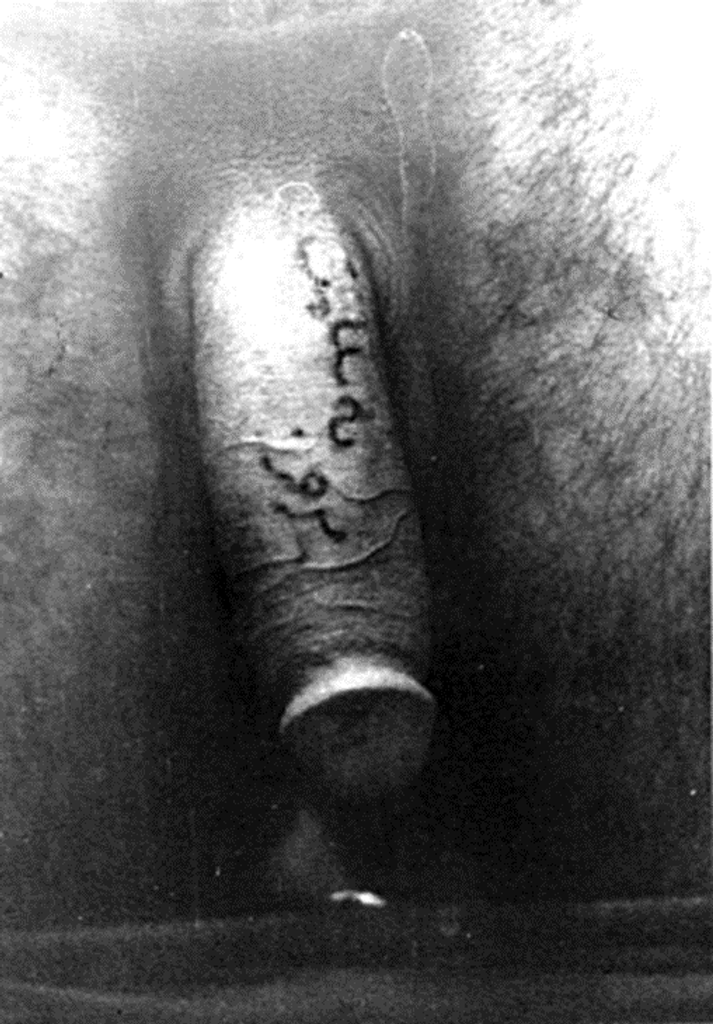A 21-year-old Iranian man has a permanent erection after having the Persian phrase “borow be salaamat” (good luck with your journeys) tattooed on his penis. He also had the letter M, the first letter of his girlfriend’s first name, inked on the penis.
He was left with a permanent semi-erection as a reminder of just how good the idea was.
His case raises several questions, not least whether the wish for good luck is directed to the penis or the man, and if it’s to the penis, where, exactly, is it going? But, medically speaking, how could getting penis ink give make the organ go haywire?
The man, whose identity remains undisclosed, received a diagnosis of nonischemic priapism—a condition characterized by the inability of blood to exit the penis properly. His medical case was outlined in the most recent publication of the Journal of Sexual Medicine.
Permanent Erection: Penile Tattoo Case
The study authors from Kermanshah University of Medical Sciences in Kermanshah, Iran, suggested that in this instance, “It is highly possible that the handheld needle penetrated the penis excessively, resulting in the formation of an arteriovenous fistula.” A fistula is an abnormal connection between two organs or vessels—such as an artery and a vein—that generally do not have a direct connection.

“After the tattooing procedure, the penis remained painful for eight days, resulting in the absence of erections,” the authors stated. “Following this period, the patient observed longer-than-usual sleep-related erections. Within a week after that, the condition progressed to a state where the penis remained constantly semi-rigid, persisting throughout both day and night.”
As erectile dysfunction pill commercials constantly remind us, non-sex-related erections lasting longer than four hours are dangerous for penises. The lack of fresh blood flow can starve the spongy tissues of oxygen, destroying them and resulting in impotence.
Men should seek medical assistance if they experience an erection lasting more than four hours.
Priapism
There are two types of priapism, ischemic and non-ischemic, according to Iranian urologists. In a normal erection, blood flows into the penis via arteries, and as pressure builds, the veins leading out are temporarily blocked. In ischemic priapism, the veins don’t open up again.
Researchers have found that this issue resolves spontaneously in 62 percent of cases. When it doesn’t, men have the option of selective arterial embolism, which blocks the problematic artery.
Instead, as per the report, the Iranian man opted to undergo a shunt implantation procedure to alleviate the excess blood.
The authors observed that the procedure was, as expected, unsuccessful. They mentioned that because the patient experiences painless erections, maintains some erectile function during intercourse, and is unsatisfied with past surgeries, they decided not to pursue further treatments and are living with their condition.
Despite experiencing a persistent erection, the man expressed no remorse regarding his penile tattoo, as detailed in the report. However, the authors caution against such practices, stating, “Based on our unique case, we discourage penile tattooing.”
Disclaimer Statement: This information is from a third-party health news channel. The opinions expressed here belong to the respective authors/entities and do not reflect the views of Docquity. Docquity does not assure, endorse, or vouch for any of the content and bears no responsibility for it in any way. It is essential to take all necessary steps to ensure the information and content provided are accurate, current, and verified. Docquity disclaims any express or implied warranties related to the report and its contents.
Reference
- Penis Tattoo Leads to Permanent Erection [Internet]. Cited from ABC News (Accessed on 11 April,2024). Available at: https://abcnews.go.com/blogs/health/2012/01/09/penis-tattoo-leads-to-permanent-erection
- Zargooshi J, Rahmanian E, Motaee H, and Kohzadi M. Nonischemic priapism following penile tattooing. Journal of Sexual Medicine 2012; 9:844–848.Doi: https://doi.org/10.1111/j.1743-6109.2011.02579.x
About Docquity
If you need more confidence and insights to boost careers in healthcare, expanding the network to other healthcare professionals to practice peer-to-peer learning might be the answer. One way to do it is by joining a social platform for healthcare professionals, such as Docquity.
Docquity is an AI-based state-of-the-art private & secure continual learning network of verified doctors, bringing you real-time knowledge from thousands of doctors worldwide. Today, Docquity has over 400,000 doctors spread across six countries in Asia. Meet experts and trusted peers across Asia where you can safely discuss clinical cases, get up-to-date insights from webinars and research journals, and earn CME/CPD credits through certified courses from Docquity Academy. All with the ease of a mobile app available on Android & iOS platforms!






